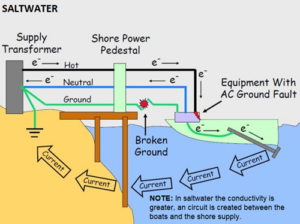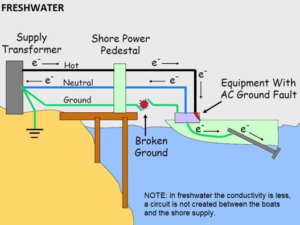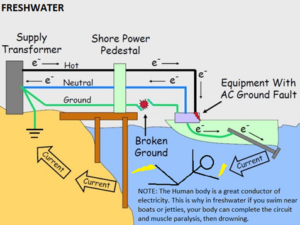Freshwater Electrocution Drownings
Preventing Freshwater Electrocution Drownings: The Crucial Role of Reverse Polarity Testing Devices (such as ESHORE)
By Mark Smith
CEng, CMarEng, FIMarEST, BAppSc(MarEng)
Engineering Surveyor
Accredited Marine Surveyor: AMSA – 3242-6148 4
Qld EC lic. 73995
Based in Brisbane, Australia, Mark Smith is an AMSA Accredited Marine Surveyor, qualified electrician, and a Chartered Marine Engineer with over 40 years’ experience. Mark is a member of the Australasian Institute of Marine Surveyors, and Fellow of the Institute of Marine Engineering, Science and Technology (IMarEST). Mark is the owner of SET Maritime & Electrical, designer of the polarity testing device – ESHORE.
This article is written to raise awareness of the dangers that can be caused by current being leaked into freshwater by faulty electrical systems on board boats. Predominantly written for those who frequent freshwater lakes mostly in USA and Europe.
Tragedies involving freshwater electrocution drownings have gained increasing attention in recent years, shedding light on the hidden dangers that may be beneath the surface of seemingly serene lakes, rivers, and dams. Electrocution incidents in freshwater environments pose a significant threat to swimmers, boaters, and anyone in contact with the water. However, advancements in safety technology, such as reverse polarity testing devices, offer a promising solution to mitigate this silent peril and save lives.
What is Freshwater Electrocution Drowning
Freshwater electrocution drownings occur when an electrical current is introduced into the water, often stemming from faulty electrical systems in marinas, docks, or boats. Unlike freshwater, saltwater is a better conductor of electricity, making it more conducive to transmitting electrical current. In a freshwater environment, when faulty wiring or electrical malfunctions occur, the current may not be transmitted to Earth due to the water being a poor medium for conducting electricity. If someone comes between the source of the current and the earth, the submerged human body will conduct the electrical currents to create a circuit to Earth. The body then becomes a path for the flow of electricity, and this can lead to serious injuries or fatalities, with victims experiencing electric shock, muscle paralysis, and drowning as a result.

Fig.1: Conductivity in Saltwater

Fig.2: Conductivity in Freshwater

Fig.3: Conductivity of a Living Creature in Freshwater
Images courtesy of Boat U.S. http://www.boatus.com/ (have been altered to include extra detail)
The Importance of Reverse Polarity Testing Devices
Reverse polarity testing devices play a crucial role in preventing freshwater electrocution drownings by testing the earthing conductor between the marina and boat. If there is a break in the earthing conductor the device will prevent an electrical connection before it poses a threat to anyone in the water. These devices are designed to detect and correct reversed electrical polarity, the common issue that can lead to energising earthing conductor or earth leakage from appliances of electric current into the surrounding water.
Reverse polarity occurs when the active, (hot), and neutral wires in an electrical system are reversed, leading to the potential for electric current to flow into the water. The installation of reverse polarity testing devices helps ensure that the electrical system is properly configured, minimizing the risk of electrocution incidents.
How Reverse Polarity Testing Devices Work
Reverse polarity testing devices work by testing that the active, (hot), and neutral wires are terminated correctly, and that the earthing conductor has continuity. This test will be conducted every time that you plug your boat into a shore connection and when power is lost, then reestablished. If a reversal of polarity is detected, the device will lock out the connection and power cannot be supplied until the active and neutral wires are terminated correctly, or the earthing conductor has continuity reestablished. This simple test creates a safer environment for swimmers, boaters, and others enjoying freshwater activities. This ensures that corrective action can be taken promptly, addressing potential hazards before they escalate into life-threatening situations.
The Impact on Regulation
The incorporation of reverse polarity testing devices is becoming standard practice in marinas, docks, and other freshwater recreational areas, and in some parts of the world are mandated. As safety regulations evolve, there is a growing awareness of the importance of implementing these devices to protect individuals from the risks associated with electrical failures in these environments.
Freshwater electrocution drownings are tragic incidents that can be prevented with the adoption of a polarity testing device. These devices help prevent many risks and serve as a vital component in creating safer water environments by identifying electrical faults before they become hazards. As advancements in innovation continues to forge ahead, authorities, marina operators, manufacturers and boat owners need to be educated in how such a simple device can prevent this kind of tragedy.